rIGHtS AreN’ t eNOUGH: We NeeD trANS p OWer
Thousands

September 27, 2023 VOL. 110, NO. 07 SINCe 1914
march in solidarity with trans community following hate rally
EDITOR-IN-CHIEF Gillian Brown editor@themanitoban.com
BUSINESS MANAGER Dhruv Patel accounts@themanitoban.com
ADVERTISING CO-ORDINATOR Diego Castro ads@themanitoban.com
EDITORIAL
MANAGING EDITOR Ezra Taves me@themanitoban.com
COPY EDITOR Simon Pensato copy@themanitoban.com
NEWS EDITOR Sarah Cohen news@themanitoban.com
NEWS EDITOR Kyra Campbell news@themanitoban.com
RESEARCH & TECHNOLOGY EDITOR Elah Ajene research@themanitoban.com
COMMENT EDITOR Jessie Krahn comment@themanitoban.com
ARTS & CULTURE EDITOR Jacob Davis arts@themanitoban.com
SPORTS EDITOR Grace Anne Paizen sports@themanitoban.com

DESIGN

DESIGN EDITOR Taeran An design@themanitoban.com
GRAPHICS EDITOR Teegan Gillich graphics@themanitoban.com


AUDIO AND VIDEO
AUDIO EDITOR Harmatpreet Brar audio@themanitoban.com
PHOTO EDITOR Ebunoluwa Akinbo photo@themanitoban.com
VIDEO EDITOR Kennedy Legault video@themanitoban.com
SOCIAL MEDIA EDITOR Violet Baker social@themanitoban.com
REPORTERS
109 HELEN GLASS BUILDING
UNIVERSITY OF MANITOBA
WINNIPEG, MB
204. 474. 6535
The Manitoban is the official student newspaper of the University of Manitoba. It is published monthly during the summer and each week of regular classes during the academic year by the Manitoban Newspaper Publications Corporation.

The Manitoban is an independent and democratic student organization, open to participation from all students. It exists to serve its readers as students and citizens.
The Manitoban is a member of the Canadian University Press, and our journalistic standards can be found on the Manitoban’s website.
The newspaper’s primary mandate is to report fairly and objectively on issues and events of importance and interest to the students of the University of Manitoba, to provide an open forum for the free expression and exchange of opinions and ideas and to stimulate meaningful debate on issues that affect or would otherwise be of interest to the student body and/ or society in general. The Manitoban serves as a training ground for students interested in any aspect of journalism.
Students and other interested parties are invited to contribute to any section of the newspaper. Please contact the appropriate editor for submission guidelines.
The Manitoban reserves the right to edit all submissions and will not publish any material deemed by its Editorial Board to be discriminatory, racist, sexist, homophobic or transphobic, ableist or libellous.


Opinions expressed in letters and articles are solely those of the authors. Editorials in the Manitoban are signed and represent the opinions of the writer(s), not necessarily those of the Manitoban staff, Editorial Board or the publisher.
A “volunteer staff” member is defined as a person who has had three volunteer articles, photographs or pieces of art of reasonable length and/ or substance published in the current publishing year of the Manitoban.

VOLUNTEERS
VOLUNTEER STAFF
Bahareh Rashidi, Matthew Merkel
VOLUNTEER
Nolan Krahn, Val Massey Misha Stone interested in volunteering? email me@themanitoban.com today!
Any individual who qualifies as a volunteer staff member must be voted in by a majority vote at a Manitoban editorial board meeting. Elected representatives and non-students may be excluded from holding votes as volunteer staff members in accordance with the Manitoban Constitution.
All contents are ©2023 and may not be reprinted without the express written permission of the Editor-in-Chief.
THEMANITOBAN.COM
2 Vol. 110 No. 07
News pages 3 to 5 Research & Technology pages 6 to 7 Editorial page 8 Comment pages 10 to 13 Diversions page 14 Arts & Culture pages 15 to 16 Sports pages 17 to 20
Join the club! Take a look at some campus student groups
Put some pep in your step
Join and watch U of M’s Pep Band at Bisons games and more
 Sarah Cohen, staff
Sarah Cohen, staff
Whether the University of Manitoba Pep Band is playing today’s hits or throwback tunes, its goal is to bring excitement and U of M spirit to crowds of Bison sports fans.
UM Pep Band is an ensemble of students from any faculty that performs for students and attendees of different U of M sports games and other school events.
In her fourth year of an arts degree, Hannah Bowers is taking on the role of president for the UM Pep Band.
Bowers has always had a passion for music, and when she moved to the U of M she noticed the lack of a pep band community for non-music students. Her idea to create a pep band for the university progressed after she contacted numerous music professors and learned that a pep
band existed years ago. She was given a few remaining drums and some sheet music, and from there, UM Pep Band began to emerge. Co-ordinating with the music faculty, U of M athletics and UMSU finally resulted in the band’s true beginning in March of 2022.
Bowers said collaborating with other pep bands from other Canadian universities has been “really great.”
She said the people who should join UM Pep Band are the students who “want a place to play and to have fun in a judgement free space, with a welcoming community.”
“[Pep Band] runs on everybody that’s in it,” she said.
To join the group, you must be a U of M student who plays any level of brass, woodwind or percussion instruments.
Fill out the interest form on the band’s Instagram to become a member.
Rehearsals are every Wednesday from 7:15 p.m. to 9 p.m. in the Desautels building. The executive team asks that you bring your own instrument and let them know you would like to attend if you are not already a member via its Instagram, @umpepband. That way, the execs can have sheet music ready for you and your instrument. Due to the band’s limited resources, the executives ask that you come to the band with some knowledge of how to play your instrument.
If you don’t want to join but still want to enjoy, you can find the UM Pep Band playing in yellow jerseys at Bison football, hockey, volleyball and basketball games this year.
Swing your way over
UMSwing still dancing strong on campus 23 years later
Sarah Cohen, staff
Join for the dances, stay to find community. At least, that’s what vice-president of UMSwing Rachit Bajpai believes.
Bajpai, in his last year of an English degree, didn’t know a single dance before joining the U of M swing dance club. Last year, when he saw a poster for an open house that advertised not needing experience or a partner, he decided to attend.
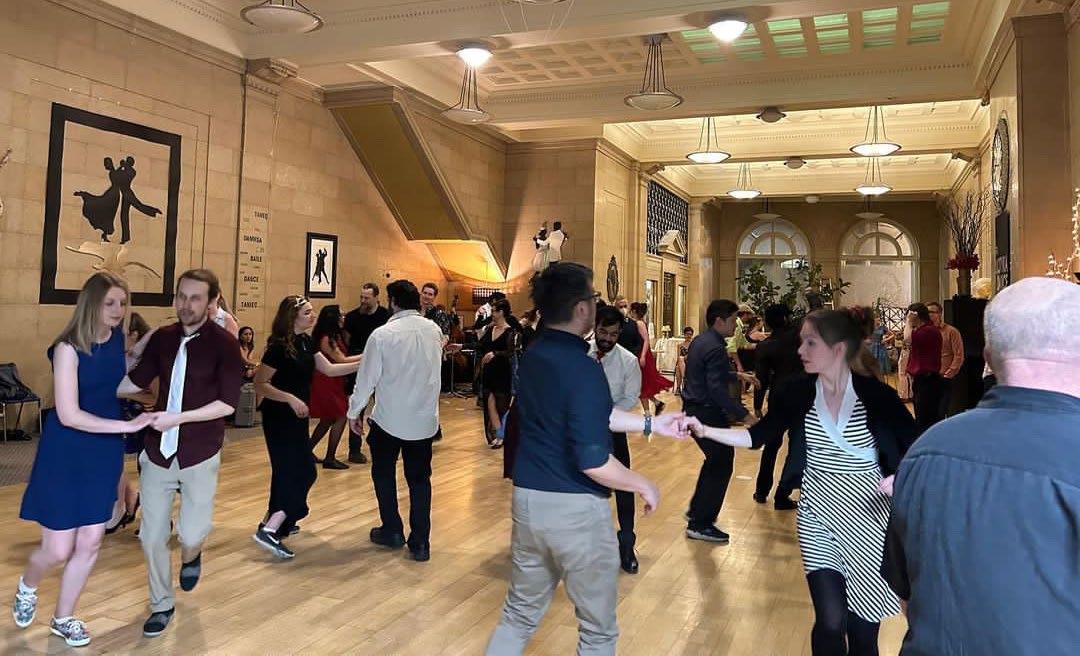
“How about I just go there [and] try something new?” He thought. “Even if I can’t do it, at least I’ll get to meet, maybe, ten new people.”
You don’t need any experience or even a partner to join the inclusive dance environment of U of M’s swing club.
UMSwing will be hosting its free open house on Sept. 29, where visitors can meet teachers, club executives and other dancers, and even try a dance or two before becoming a member in full-swing. More details can be found on Instagram @UMSwing, but one way to become a member is to attend the open house or send the club a direct message.
Attending various dance lessons and workshops comes with a small fee in order to provide well-
trained instructors, but joining as a member is free.
UMSwing holds dance lessons regularly throughout each semester, along with various workshops and other events, like last years’ Fool’s Ball where participants had the chance to dance to live music in their best formal attire. The club also occasionally goes for “s’wings nights,” where members enjoy chicken wings and hang out with friends after dance lessons.
You can show up to lessons and workshops by yourself or with a partner, just be sure to bring water and wear active clothing.
If you join UMSwing, Bajpai said to expect many opportunities to meet and dance with old and new club members. Bajpai got the chance to speak to the founder of UMSwing, who has since moved to Montreal to dance. When asked what else potential members could expect, Bajpai emphasized the fun they’ll have.
“I believe that’s the reason we’ve been [here] for [this long],” he said.
“Sometimes university does get stressful, and it’s really nice to have people who are not in your class […] and just interact [and] have fun,” Bajpai said.
3 news@themanitoban.com September 27, 2023 News
photo / UmSwing / provided
photo / p ep b and / provided
U of M group advocates for livable basic income
Group focused on advocating for Manitoban’s basic needs ahead of provincial election
Kyra Campbell, staff
The cost-of-living crisis and systemic barriers are causing increased financial strain for many, including university students. Now, one group of U of M staff and students is examining the issue of poverty and advocating for systemic change ahead of the provincial election on Oct. 3.
Bare Necessities is a group created by U of M Community Engaged Learning staff and students in partnership with Poverty Awareness and Community Action, a U of M program that raises awareness and offers advocacy workshops for students and the broader Winnipeg community.
The group aims to teach staff and U of M students “how to participate in social advocacy campaigns that may impact elections,” such as the provincial election currently underway. Bare Necessities’ main advocacy goal is to transform Employment and Income Assistance (EIA) into a livable basic needs benefit.

Currently, 146,000 Manitobans live below the poverty line, and those on EIA’s basic needs budget receive $245 monthly.
Anny Chen, program coordinator for Poverty Awareness and Community Action, and Madelaine Ricard, a recent U of M anthropology graduate and volunteer social advocate with Bare Necessities, see a livable basic needs benefit as the best policy for Manitobans. The group hopes that the program will allow people to thrive and lower the stigma of government assistance, as all Manitobans would receive the benefit, said Chen.
“If we start from the premise that people will be their best versions of themselves if they have their basic needs met, I think we could have a thriving society,” said Chen.
Ricard described the livable basic income benefit as a policy that would transform the current EIA system into one where all Manitobans receive a baseline income tied to inflation, that would cover one’s basic needs.
Through advocating for a
well as an increased amount of people who are now struggling due to recent events.
“ We can relate more to this issue, now more than ever,” said Chen.
The group has been active in its advocacy work, according to Ricard, who said members have been attending political events and calling on candidates to support their cause.
they earned while working.
The experiment’s goals were to see the social effects of such a program, if people left the workforce due to it, how an income program could be widely implemented and whether or not it could become an alternative to social assistance.
income program on its own is not enough. The group would also like to see action taken to increase affordable housing, affordable transit, free healthcare, and a free education system.
livable basic income, Ricard hopes the group’s work will remind Manitobans that people are not choosing to live in poverty and that “people in poverty are people first.”
Chen noted that this time for advocacy is significant, as the COVID-19 pandemic and rising costs have affected people who have been experiencing poverty for an extended period of time, as
“No one should be struggling to house themselves or feed themselves.”
Richard said. “These are basic human rights.”
The notion of a basic income is not new for Manitoba. In 1974, the community of Dauphin, Man., was home to a government-supported income experiment. On average, a family of four would receive $16,000 annually as a basic income, plus the money
The program ended in 1979 due to changes in governing political parties and global political crises. However, the program did produce some promising results, including an increased rate of youth completing high school and a decline in hospitalizations by 8.5 per cent.
Ricard and Chen hope that Manitoba’s historical ties to basic income and newfound motivations for structural change could send a ripple effect of action across other provinces.
As election day draws closer, Bare Necessities is focused on advocacy, especially voter action. The aim is to highlight the concept of a basic livable income benefit so that Manitobans can be informed on the issue come election day and ask their candidates if their government would support a basic income. “Ultimately, we need policy to change, and we need the structures to change for people to experience something different than what they are now,” said Chen.
While advocating for a livable income is the primary goal of Bare Necessities, Chen and Ricard said that an news@themanitoban.com

4 news@themanitoban.com Vol. 110, No. 07 News
photo / e bunoluwa Akinbo / staff
“No one should be struggling to house themselves or feed themselves”
— Madelaine Ricard, volunteer social advocate with Bare Necessities
New OCD support group to begin operating in Winnipeg
The group will focus on peer support, free of charge to join
Kyra Campbell staff
Anew obsessive compulsive disorder (OCD) peer support group for adults, called Winnipeg OCD, will begin operation in early October.
Lisa Walter, creator of Winnipeg OCD and a peer support group facilitator, noted in a press release that with September being Suicide Awareness Month, she hopes the group will create a sense of community for those who may feel isolated by their symptoms.
Walter, who herself dealt with intense symptoms of OCD for five years, learned the importance of treatment through her time at the McLean Hospital in Boston.
“Now that I’ve learned these skills and I’ve done a lot of peer support with people over the years, here I am in Winnipeg, and there’s a drought of services,” said Walter.
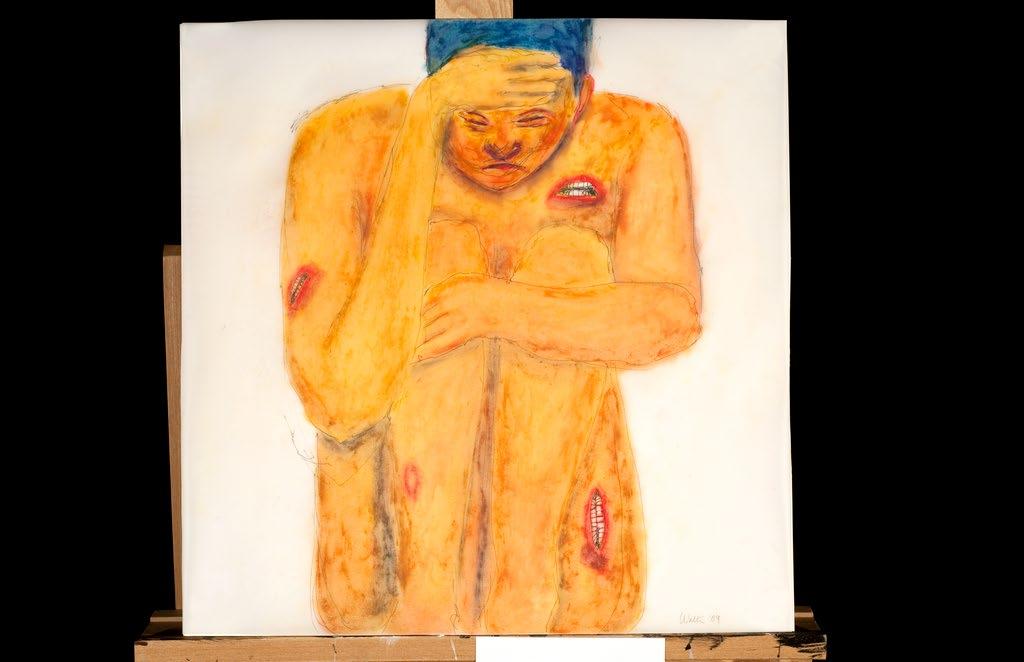
When creating the group, Walter noticed the need for comprehensive OCD treatment services in Winnipeg, but these services come at a steep cost. A clinic out of St. Boniface offers services, but it can be inaccessible for many
due to long waiting lists, a common problem in Canada.
“As someone who really suffered with it, it really struck me just how few services there are,” said Walter.
Diane Davey, member of the International OCD Foundation and program director of the McLean Hospital OCD Institute where Walter underwent treatment, praised Walter for her initiative.
Davey was quoted in Winnipeg OCD’s press release saying that “Lisa brings a lot of insight and compassion to the OCD community and I’m excited to see her putting this to work for Winnipeg.”
Walter hopes that this group will be a starting point for group members when it comes to taking control over their own lives, and that people will learn how to “become their own therapist” if that’s what someone finds easiest while starting out.
This treatment would involve working in collaboration with experts and others who are experiencing OCD symptoms. Walter noted that Winnipeg OCD will not replace the work of therapy, but will complement it though
self-help and a supportive environment.
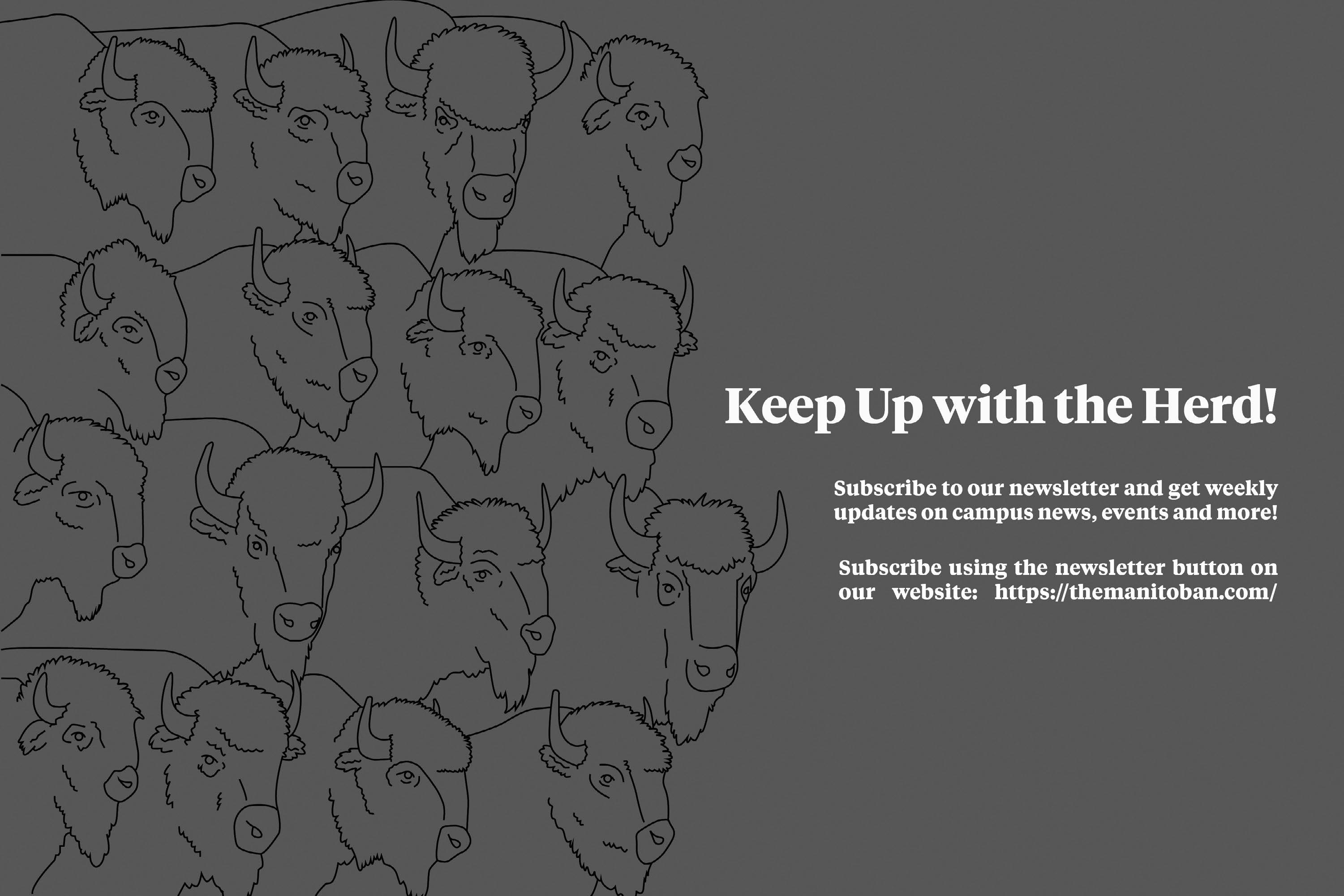
One of the most powerful reasons for putting this group together, said Walter, is “so that people don’t [think] they’re alone.”
After members form the group, they will decide how it will function themselves. Walter said that she does not want the structure to be her simply lecturing in front of participants. Instead, she hopes for a community of individual and collaborative growth. Through this structure, participants will choose topics of discussion, where everyone can bring their input and follow up by learning new coping skills.
Walter also explained the possibility of helping participants find self-help books they feel comfortable with. Participants would then come to the group and explain what worked and what didn’t, so that fellow members and staff can help find possible solutions.
The intention of the group is to be a relaxed environment, a place where people can open up about their struggles and make room for the
issues that can arise when discussing OCD. Through connecting with others facing a similar battle, Walter thinks particpants will see their strengths as she did through treatment.
“Mental health diagnoses are all organized around deficits. I believe in seeing what people bring to the table,” said Walter.
Walter noted that large changes such as starting university can bring additional stressors to one’s life.
“The important thing is to address it before it takes over your life,” said Walter.
The group plans to begin meeting Oct. 5 and will meet
bi-weekly, and there is no cost to participate. For those who wish to attend the group, please provide your name and contact information to Lisa prior to the first meeting.
For students interested in joining Winnipeg OCD, Lisa can be contacted via Instagram @winnipeg_OCD, Facebook page Winnipeg OCD or email at WpgOCD@proton. me.
news@themanitoban.com
5 news@themanitoban.com September 27, 2023 News
photo / provided
Led by curiosity and adaptability
David Levin shares his journey as a professor in biosystems engineering
elah Ajene, staff
David Levin grew up in Winnipeg’s North End, where he played football for the St. John’s Tigers as a middle linebacker.
After graduating high school, a crossroads emerged in his first year at the U of M — Levin had to choose between pursuing football with the Bisons or his academics.
“I did my first year at university, but like most young people, I was pretty dazed and confused,” he said. In his second year, Levin went to the University of Waterloo, where he joined a liberal arts and humanities program and studied philosophy.
During this period, books like The Limits to Growth and Small Is Beautiful resonated with youth looking to change the world. Levin was among them, seeking answers in a world filled with challenges and confusion.
A turning point arrived when he discovered the works of philosopher Karl Popper. Popper’s book The Logic of Scientific Discovery championed empirical falsification through experiments, asserting that evidence should determine the validity of our stories about the universe.
This resonated deeply with Levin, who now embraced the idea that knowledge should evolve based on evidence.
Around the same time, Levin developed a growing fascination with insects while working at an apple orchard for a few summers. He studied the insects that plagued the orchard, trying to determine how to control them without using pesticides. This experience led him to attend the University of Guelph, where he studied insects and their biological control.
At Guelph, Levin’s focus shifted toward viruses after he encountered a small green cat-
erpillar known as the cabbage worm. His research investigated its interaction with parasitic wasps and viruses.
“Through that, I kind of learned that viruses are really cool,” he said.
After completing his master’s, Levin continued to merge his fascination with insects and viruses in his work. He collected insects in
gen production. This venture led him back to the U of M to collaborate with professor in the department of biosystems engineering Nazim Cicek and professor in the department of microbiology Richard Sparling.
Now a professor in the department of biosystems engineering, Levin is involved in research projects focused on biodegradable polymers and microbial and enzymatic degradation of polymers, such as plastics.
Last Wednesday, Levin spoke at a seminar hosted by the faculty of agricultural and food sciences on his international collaborations within the field of bioengineering and biotechnology.

Throughout his career, Levin has actively cultivated international collaborations on a variety of projects, which have taken him to the United States, New Zealand, Italy, Switzerland, France, China and Japan.
and collaboration in scientific endeavors.
“Everything we do as human beings is about communication,” he said.
“If you’re the smartest person in the world, and if you can’t communicate with anybody, then what good is it?”
Reflecting on his teaching experience, Levin finds great fulfilment in sharing his passion for science with young, motivated students.
Botswana, Malawi and Kenya and got a job at the veterinary college at the University of Guelph before completing a PhD in bacteria phages at McGill. After graduating, he completed a postdoc in Montreal and went on to work at the University of Victoria.
The researcher would soon encounter the concept of the hydrogen economy and the potential for biological hydro-
His aim is to use enzymes and microbes to engineer a sustainable solution for polymer degradation.
“Basically, allowing the bacteria to use the plastic as a food source and grow and then ultimately, hopefully completely break them down,” he said.
“And then ultimately, we can develop technologies that can be used for engineered processes to degrade plastic.”
Notably, these collaborations have resulted in the acquisition of advanced research tools, such as the unique Titration and OffGas Analysis System from Scion Research in New Zealand. This instrument allows real-time monitoring of volatile gas production during fermentation, providing valuable insights into microbial processes.
Levin attributed the success of these partnerships to effective communication and connecting with people on a human level, and stressed the importance of understanding
“Even if you connect with one person and you see that light bulb go on, then you’ve done your job,” he said.
From football and philosophy to insects and viruses, Levin’s path to biosystems engineering was led by his curiosity. For those still navigating their academic or professional paths, Levin offered some advice.
“Find a passion, follow it.”
research@themanitoban.com

Research & Technology 6 research@themanitoban.com Vol. 110, No. 07
“
photo / e bunoluwa Akinbo / staff
Find a passion, follow it”
— David Levin, U of M professor in the department of biosystems engineering
UM hosts speaker series on clean water and sanitation
Addresses water quality disparities in Indigenous communities in Manitoba
elah Ajene, staff
In 2018, the University of Manitoba was named the United Nations Academic Impact (UNAI) Hub for Sustainable Development Goal (SDG) 6 — clean water and sanitation.
As part of its Last Drop UNAI Speaker Series, the U of M hosted a seminar last Monday titled “Microbiological quality of drinking water from First Nation communities in Manitoba and an urgent need to upgrade the water distribution system.”
The talk, presented by U of M associate professor in the department of microbiology Ayush Kumar, addressed water quality disparities in First Nations communities in Manitoba.
Water contamination, often driven by microbial factors, poses serious health risks. Contaminated water can harbour bacteria and viruses, serving as a source of infectious diseases. Kumar noted that access to clean water or a lack thereof has a direct correlation with life expectancy. Drinking water advisories are precautionary measures aimed at safeguarding individuals from drinking contaminated water. These include boil water advisories, do not consume advisories and do not use advisories.
“There are communities out there which have one or more of these advisories ongoing at the time,” Kumar said.
Advisories that persist for over a year, known as longterm drinking water advisories, have been a focal point for government efforts to ensure safe drinking water in Indigenous communities.
Recent data suggests that progress has been made, with the number of long-term advisories in Canada decreasing. For example, there are now five remaining advisories in Saskatchewan, three in Manitoba and 20 in Ontario, totaling 28 across the country. This marks a substantial reduction from the more than 120 advisories that existed in 2015.
However, the numbers alone do not tell the whole story.
“This is not the complete picture when it comes to the quality, or the lack of it, of drinking water in First Nation communities,” Kumar said.
Many Indigenous communities depend on private water sources, well systems and residences without water
services. Kumar highlighted that there are no established systems used in monitoring the water quality within these households yet. This critical gap led to a collaboration between researchers and community members to collect and analyze water samples and microbial quality of water from various Indigenous communities.
Kumar pointed out that none of these communities were under any drinking water advisory, long-term or otherwise. Additionally, they all had water treatment plants and a mix of water distribution systems, including pipelines and water truck deliveries.
The collaborative study focused on two bacteria that are key markers of microbial contamination — coliforms and E. coli. While coliforms are not always pathogenic, their presence indicates fecal contamination, which can carry disease-causing organisms.

“The guidelines say that drinking water — to be safe for drinking — should not have a single coliform or E. coli,” Kumar said.
However, the tap water samples col -
lected from these communities did contain coliforms. Although the water treatment plants effectively removed these bacteria, the bacteria reappeared in the distribution system, indicating potential recontamination.
To gain a deeper understanding, Kumar and his team conducted microbial community analysis, similar to fingerprinting, to identify the types of microbes present. The results showed a clear difference in microbial profiles between an untreated source water and system water, suggesting that contamination was not originating from the source. The
study also examined antibiotic resistance genes in water samples. Antibiotic resistance is a growing global concern, and resistance genes can be present in water sources.
According to Kumar, “The impact of resistance is very widespread when it comes to health of the community and health-care system.”
Kumar found the presence of antibiotic resistance genes in system water samples. Additionally, system water samples stored in various materials like cement and plastic tanks consistently showed higher bacterial counts and antibiotic resistance genes.
E. coli or coliform contamination.
For Kumar, this shows that “if we have to target one aspect of water distribution system, or if we have to prioritize one aspect of water distribution system, we have to look very carefully at water storage in these systems.”
While progress has been made in reducing long-term drinking water advisories, the complexities of water quality in Indigenous communities extend far beyond advisory labels. System water quality, microbial contamination and antibiotic resistance remain significant concerns.
Kumar emphasized the importance of sharing data and community engagement in fostering a deeper understanding of water quality issues and ensuring access to clean and safe drinking water. “Systems are probably the biggest health risk when it comes to access to safe water,” he said, “and this is something that needs to be addressed.”
“What this is telling us is that we need to have a policy in place to ensure that these systems are cleaned in a timely manner,” Kumar said. Kumar also looked at the presence of campylobacter, a pathogenic bacteria that causes severe gastrointestinal tract infections. Typically, these infections have been linked to the consumption of raw or undercooked pork and poultry. However, the study detected campylobacter genes in water samples, even in samples that showed no signs of research@themanitoban.com
7 research@themanitoban.com September 27, 2023 Research & Technology
graphic / bahareh rashidi / volunteer staff
Manitoba should have no space for hate
Dog whistles in provincial election campaign symptom of larger issue
In case students somehow missed the visual cacophony of political signage on their trek to campus, the Manitoba provincial election is this upcoming Tuesday, Oct. 3.
To say this provincial election has been an embarrassment is an understatement.
From straight-up dog whistles in political advertisements to campaign pledges, the trudge to the ballot box has been disgraceful.
While this editorial reads the recent uptick of divisive politics as a product of recent Canadian history, provincial politicians seem to be steepening that uptick. The question that begs to be asked this election cycle is: why is the Manitoba Progressive Conservative (PC) party running a campaign to appease voters using — via their own campaign ads, no less — dishonest communications strategies?

Racist ads have sprouted up across the city on bus benches, one of the worst featuring a cop, arms crossed, telling us how the only province in Canada founded by Indigenous leadership would turn into The Purge overnight if the party led by an Indigenous man was elected.
This editorial could be 30 pages of the Manitoban if the preferred word count allowed space to unpack the astronomical levels of racism within this ad alone. Policing has had a close relationship with anti-Indigenous violence — from cops committing historical starlight tours against Indigenous Peoples, to Indigenous men being stereotyped as violent criminals. It has me wondering why a city police officer is even allowed to have a say in a provincial election?
Next, we have the ads that claim children in the province need to be protected from what is being taught in public schools. Parents already — checks notes — have rights over their children, can consult the government of Manitoba website about what’s going on in schools and have the power to homeschool their children if they don’t agree with what’s being taught in the classroom.
Dog whistling, or cryptic messaging that lends the speaker plausible deniability but still registers with those in-the-know, has been a key component of the PCs’ communications. Much like a real dog whistle is not audible to the human ear, most of the public does not register that right-wing dog whistles cover
for broader agendas.
The PCs’ promise of “fighting for parental rights” is, in recent years, not only an anti-2SLGBTQIA+ dog whistle, but a racist dog whistle that has led to our southerly neighbours banning critical race theory in some states. This excuse was used in an attempt to ban 2SLGBTQIA+ books in the Brandon School Division this May. The public hears “parental rights” while white supremacists and transphobes hear “erase marginalized people from the public eye.”
The “1 Million March 4 Children” that culminated last Wednesday to “protect” kids was yet another real-life consequence of when politicians are allowed to peddle hate.
Popular culture points to former president Donald Trump for bringing divisiveness and polarization into the political mainstream, but we are remiss to ignore Canada’s own contribution to this rhetoric.
Recent iterations of extreme right-wing Canadian politics can be traced back to when the federal Reform Party of Canada — a fringe, populist conservative party founded in 1987 — snowballed into the just-as-hard conservative federal Canadian Alliance party in 2000. In 2003, Stephen Harper, leader of the Canadian Alliance at the time,
talked then-federal Progressive Conservative party leader Peter MacKay into merging the parties to become the Conservative Party of Canada.
The Conservative party would win the federal election in 2006 and Harper would go on to rule over Canada as prime minister for nearly a decade until the party was voted out in the 2015 federal election.
To quote John Oliver’s spin on Hannah Arendt’s famous line, “where there is banality, there is evil.”
“The nerd who came from nowhere,” Harper discontinued a session of government twice to hold onto power: once in 2008 to evade a no-confidence vote, and a second time in 2009 during an inquiry into the treatment of Afghan detainees, where the shutdown would allow the Conservatives to gain majority control of the Senate when parliament was back in session.
Harper also muzzled scientists from sharing research with the public about climate change during his tenure. He stalled government action on climate change for nine whole years, paving the path for conspiracy theories that climate change is a hoax, because “suddenly” there were climate change reports that weren’t around in Canada during Harper’s tenure as PM.
Most infamously, Harper established the “Barbaric Cultural Practices” hotline in 2015 during the election campaign. The creation of this racist hotline was a direct result of new immigrant Zunera Ishaq pushing back on the Conservative government’s 2011 policy that banned face veils when she wished to wear her niqab during her 2014 citizenship ceremony.
Those who are just reading about this part of recent Canadian history will be happy to know Ishaq not only won her battle in court, but wore her niqab during her citizenship ceremony in 2015. However, the damage of conservative politicians claiming to protect “Canadian values” had already been done and Harper was never shy about using dog whistles, saying “old stock Canadians” outright during the 2015 Globe and Mail federal election leadership debate.
Recently, Harper, who is currently chairman of the International Democratic Union — a conservative global collective that promotes rightwing policies around the world — claims the Canadian media had a role in the Conservative Party’s 2015 federal election loss.
landscape pre-MAGA. These politics have bled down from the federal levels of the Conservative party in Canada to the provincial levels.
The dog whistle — that was more like a foghorn — of the “Barbaric Cultural Practices” hotline has morphed into calls to protect children against being indoctrinated by the 2SLGBTQIA+ community. Climate change as a hoax is reflected in the Manitoba PCs’ election platform, does not include any campaign pledges to protect the environment.
And the rhetoric of the PC campaign is an absolute “us versus them” mentality. The PCs’ slogan is “Fighting for Manitobans.” Fighting against what exactly? What is a party who has been in power for the last seven years fighting against? Themselves? Morals? Ethics?
The PCs should be embarrassed about running such a divisive campaign. It’s 2023. There should be no dog whistles in politics, and those who use them should be punished. Yet, where are the adults in the room? Where is Elections Manitoba’s enforcement of their “Code of Ethical Conduct”?
There should be no space for hate in this province.
The majority of these problematic actions and principles, then, were established within the Canadian political editor@themanitoban.com
Editorial 8 editor@themanitoban.com Vol. 110, No. 07
Grace Anne paizen, staff
graphic
/ t eegan Gillich / staff







UMSU EXECUTIVE OFFICE HOURS (Fall 2023) Divya Sharma VP Community Engagement WEDNESDAYS @ 12-1PM UMSU table near Fireside Lounge 1st Floor - UMSU University Centre Tracy Karuhogo President TUESDAYS @ 12-1PM UMSU table near Fireside Lounge 1st Floor - UMSU University Centre Liam Pittman VP Advocacy THURSDAY @ 12-1PM UMSU table near Fireside Lounge 1st Floor - UMSU University Centre Vaibhav Varma VP Finance & Operations TUESDAYS @ 12-1PM UMSU table – 3rd Floor UMSU University Centre Christine Yasay VP Student Life MONDAYS @ 12-1PM UMSU table near Fireside Lounge 1st Floor - UMSU University Centre UMSU + UPSSA Provincial Leaders Townhall September 27 Fireside Lounge 1st Floor UMSU University Centre 3-5pm Free cookies & coffee THE PROVINCIAL GENERAL ELECTION WILL BE HELD ON OCTOBER 3, 2023 GOTV GET OUT THE VOTE Make sure to have your voice heard by heading to the ballot box to cast your vote! YOUR VOTE MATTERS! FALL BAKERY ITEMS! owned by UMSU 3RD FLOOR, UMSU UNIVERSITY CENTRE www.UMSU.ca @my.umsu
Men’s sexlessness societal win, hookup culture not real
Just say you’re a sexist prude already
Jessie Krahn, staff
These are sexually twisted times for sexless men and sex-frenzied 20-somethings.
In the United States, nearly one in three men between the ages of 18 and 30 report having no sex at all in the past year, while nearly one in five women in that age bracket report the same. Both statistics have jumped from hovering around 10 per cent in 2008.
Data on how much sex people have when they are outside the gender binary is nonexistent as far as I can tell, which seems like an oversight. We can’t know how much sexlessness seems to be sweeping the continent unless we survey everyone. So the conversation around sexlessness and promiscuity is full of holes and often does not factor in anyone who isn’t straight.
Although both young men and young women are having less sex these days, men’s higher rates of celibacy get the most real estate in headlines. Google “men having less sex” and “women having less sex” and you’ll notice the former search nets articles with men in the headline. Meanwhile, searching the latter yields a slew of articles about why everyone generally is having less sex.
There are lots of theories on why men specifically aren’t getting any. Men’s sexlessness seems to coincide with reduced labour force participation, hence the sexless spike after 2008. On the other hand, according to researcher Tsung Chieh Fu, a lot of young people particularly are playing video games and spending a more time on social media.
That’s right, your friends boinked because Valorant and TikTok weren’t inflating their screen time.
Then again, an article in Huck magazine examined case studies of men claiming they self-sabotage when sex is on the table. Whatever the case may be, men’s increasing sexlessness is a complex thing.
What’s interesting to me is this surge of virginal and/ or celibate lifestyles has coincided with the rise of a so-called hookup culture. More people than ever are having no sex, but at the same time, paradoxically, more people are apparently turning their backs on monogamous sexual relationships in favour of casual fucks.
It’s hard to pin down what the problem is with hookup
culture in the mainstream view. A viral Reddit thread posted in 2020 to r/unpopularopinion provides some answers, but they’re disconcertingly illuminating.
The thread’s original post claims sex in a long-term monogamous relationship is “always better” and abruptly states that “STDs aren’t sexy” as if casual sex and safe sex are mutually exclusive. Users respond that sex should be “a big deal” again, that sex between near-strangers is now considered normal (what the problem is with that is anyone’s guess), and that hookup culture is “disgusting.”
Some argue that hookup culture poses unique risks to women. An article from Thought Catalogue suggests that women could be “sexually coerced” to the point they “face the dangers of hookup culture even if they don’t wish to participate.”
However, the fact of the matter is hookup culture isn’t real. Studies as early as 2014 have refuted that hookup culture exists, with one study by researchers Martin A. Monto and Anna G. Carey finding “no evidence of substantial changes in sexual behavior” that would indicate university students in particular are having more sex with strangers. That certainly tracks with increasing rates of sexlessness.
Hookup culture is a phantom haunting us on a grand scale right down to a local one. An article from the Brown Daily Herald looked specifically at the culture at Brown University and found that although students perceived their peers’ sex lives as highly active, they were really wrong.

I’ll jump to the point here: I think the racket about men’s sexlessness specifically, as well as the range of reactions to hookup culture all stem from the general public’s refusal to acknowledge violence against women. The purported problems with sexlessness and hookup culture alike are, in actuality, symptoms of patriarchy and rape culture.
There is a chain of terrifying associations underlying headlines about sexless men. If men are not voluntarily having less sex, that means we might be facing an epidemic of incels who believe that they are entitled to sex from women. Some people have already taken that leap, interpreting rising rates of sexlessness as a sign that people should have a right to sex.
That is a highly alarming position in no small part because anyone’s right to sex jars with the rest of society’s right to not have sex. If nobody wants to have sex with a particular man, the only solu-
tion to fulfil his hypothetical right to sex would be to waive the need for his sex partners’ consent or, in other words, to allow rape.
And here we arrive at the reason why men’s sexlessness makes headlines. Although women cannot control men’s participation in the labour force, nor addictions to League of Legends, the unspoken accusation is that men’s celibacy is women’s fault for not having sex with them.
This allergy to acknowledging rape culture seeps into conversations about casual sex too. What are popularly known as problems with hookup culture are in fact symptoms of rape culture and patriarchy which we mislabel as problems with promiscuity.
For instance, the feeling some women have that they must have sex even if they don’t want to is not inherently a characteristic of casual sex. In fact, most sexual assaults — nearly 80 per cent — are instigated by someone close to the victim. The feeling that women are engaging in sexual practices they don’t want to is a trait of a rape culture, a widespread attitude devaluing safe sexual activity and promoting sexual violence.
men.
What is the solution for us, particularly women, if casual sex is supposedly a problem?
This is how the anti-hookup culture crowd’s agenda collides with men’s unfuckability. Women, apparently, owe men sex, but we are also somehow at risk for pursuing sex with more than one partner. The only solution is for us to have sex strictly within the sanctity of marriage, lock ourselves in a man’s domicile, available for sex whenever he wants it, never saying no and certainly never having sex with another man. Don’t bother even asking about sex with women.
Sex is both a normal and non-mandatory part of human life. It should not be a big deal, but the way we practise it — safely, consensually — should be. Sexual practices are all tangled up with wonderful things like love and orgasms as well as horrible things like misogyny.
We cannot have a productive conversation about getting people to live the healthy sex lives they want if we’re going to pretend abstinence is the answer and patriarchy isn’t the problem.
If we were really worried about protecting women from sexual assault, we’d just be telling them not to get close to comment@themanitoban.com
Comment 10 comment@themanitoban.com Vol. 110, No. 07
graphic
/ t eegan Gillich / staff













HEEBIE-JEEBIES.CA PAY TO GET IN. PRAY TO GET OUT. WINNIPEG’S MOST TERRIFYING HALLOWEEN EVENT Come into our haunted corridors where you’ll encounter scenes straight out of your worst nightmares. Or linger outside with your fellow scaredy-pants, where there will be food trucks and photo ops. Each of our five mazes varies in length from 8–12 minutes, while taking years off your life. Plan for 2 to 3 hours for the full experience. Sorry, no costumes allowed. Expect fog, strobe lights, special effects and more than 125 costumed actors. Our cast will never make physical contact with Heebie Jeebies guests. See these creatures and more, in flesh and bone and all their grisly, gory glory! 53071 LA SALLE RD. 1 KM SOUTH OF M c GILLIVRAY BLVD. INSIDE THE PERIMETER Archangel fireworks and unlimited re-entry to all mazes.* *SELECT NIGHTS ONLY TICKETS AVAILABLE ONLINE ONLY OCTOBER 5, 6, 7, 8, 12, 30, 31 • 7 PM–11 PM OCTOBER 15, 19, 22, 26, 29 • 6:30 PM–12 AM OCTOBER 13, 14, 20, 21, 27, 28 • 6:30 PM–12:30 AM No costumes or face paint allowed. While we don’t have an age restriction, HEEBIE JEEBIES is not recommended for children under 13 years of age. HEEBIE-JEEBIES.CA FIVE INTENSE MAZES – ONE PRICE ALL NEW 5 MAZE! 2 NEW ROOMS! 25% MORE SCARES! MORE SCARES! MORE ANIMATRONICS! 2023 PARTNERS 4 FOOD Trucks FREE Hot Chocolate* MULTIPLE Photo Ops CARNIVAL Games *HOT CHOCOLATE OFFERED FOR A DONATION TOWARDS LOCAL CHARITIES ON OCT 14 TH , 21ST AND 28 TH SEE CALENDAR FOR DETAILS. Escapes, Magic, Stunts and More! Winnipeg’s Most Dangerous Performer LIVE! Nightly
To protect trans kids is to demand a better future
Protests last week show need for solidarity with queer community
Simon pensato, staff
It seemed like the fascists wanted to hurt us.
The anti-queer 1 Million March 4 Children (1MM4C) protest in Winnipeg last Wednesday drew far larger numbers than those of us who showed up to oppose it were prepared for. Despite this, hundreds of counter-protesters stood their ground.



A coalition of U of M student advocacy groups shared a “no space for hate” graphic on social media calling for the counter-protest last week. These students showed tremendous courage in speaking out. However, a lack of co-ordination between them and other Winnipeg activists and organizations and miscommunication about the protest they were opposing resulted in a scattered response.
Beginning at 8:30 a.m. that day, counter-protesters gathered in droves and then partially dispersed before the bulk of the 1MM4C had arrived. We didn’t yet know that a second march from the Forks was still headed our way.
This left a much smaller group at the front of the legislature to stand its ground as protesters shouted slurs and carried hateful anti-queer and anti-trans imagery. We are lucky that there weren’t more major incidents of violence given the lack of legal observers or community safety groups at the event. Elsewhere in the city, queer-owned business Willow Press had its windows smashed.
It was left to individuals and small groups to figure out how to respond to protestors and provocateurs.
The following Sunday, Rally for Trans Youth was held to bring the community together in response to the Wednesday debacle. This well-attended and organized rally met at the legislature and marched down Broadway to the Canadian Museum for Human Rights. It was incredibly encouraging to see so many people show up, and to be around so many other queer people after such a difficult week.
Speakers at the beginning of the march rightly criticized the Manitoba Progressive Conservative (PC) government
for implicitly encouraging Wednesday’s show of hatred with its current campaign around “parental rights.” The PCs have ramped up their use of anti-queer dog whistles and are in clear alliance with the protestors on Wednesday.
Wednesday should be a wake-up call both for organizers across the city and for the general public. Far-right politics are on the rise and are being mobilized in the streets. The current attack on trans people is a sign of a continuing and growing fascist presence in Canada, one that we have seen gain momentum in recent years with movements like the Freedom Convoy.
In Manitoba, none of the mainstream provincial political parties make any promises in their platforms to protect or extend support for queer people, including the Manitoba Liberal Party and the Manitoba New Democratic Party (NDP). Only the Green Party of Manitoba and the Communist Party of Canada platforms contain action items that would explicitly benefit the queer and trans community.
In particular, the lack of support within the NDP platform feels like a betrayal of the movement, given that party members gave speeches encouraging protestors to get out and vote during the Sunday rally. It feels insulting to be expected to vote for parties merely because they aren’t openly hostile toward queer and trans people.
We need a bold anti-fascist response that goes beyond the lacklustre platforms on offer this provincial election to protect queer and trans people from this current rise of hate, and to put forward a vision for a better future.
As we saw on Wednesday, the present rights-based framework of legal protections for trans people in Canada is not enough to counter hatred. Right now, bills in Saskatchewan and New Brunswick are stripping trans children of their rights to privacy and safety, which could happen in any Canadian province. Even the rights-based framework we currently have in place is remarkably vulnerable to attacks from the right.
Our marches should be led by those on the frontlines of issues that are impacting trans people the most, and right now, that isn’t happen-
ing. We need better research into how the right is organized so that we can more effectively respond in the future. We need an unapologetic and uncompromising response to the right, one that doesn’t cede any ground to them.
Instead of demanding rights under the current framework, we need to clearly articulate a vision of the future in which queer and trans people can enact self-determination. This future requires free and accessible health care on demand and an end to carceral and police violence that disproportionately affect Black and Indigenous people and other people of colour, queer and trans folks, the working class and disabled communities — communities that overlap and intersect.
The events of this last week show a clear need for better organization in defence of queer communities and for an emancipatory politics, one that goes beyond protecting rights and demands material changes to our everyday conditions.
comment@themanitoban.com
12 comment@themanitoban.com Vol. 110, No. 07 Comment
photo / Val m assey / provided
misha Stone, volunteer
Rise up, gamers: the corporate miasma of professional League of Legends
The politics of e-sports remind us to respect labour
Nolan Krahn, volunteer
My fall semester so far has involved neglecting my growing September backlog of games in favour of the most divisive video game of our time, League of Legends (LoL).

I am no average League player in that I seldom play the game anymore. But as a LoL e-sports fan anticipating Worlds 2023, the global championship, this October, I’ve been reflecting on the post-lockdown politics of the League Championship Series (LCS), North America’s premier professional LoL League.
Last year, an investigation initiated by Riot Games — the developer of LoL in charge of the entire LCS — revealed the CEO and co-founder of e-sports organization Team SoloMid (TSM), Andy “Reginald” Dinh, had a history of abuse and harassment in the workplace.
It took a scathing Twitch stream from renowned pro player Yiliang “Doublelift” Peng in 2021 sparking widespread social media awareness of the issue for Riot to act. Apparently, videos from as early as 2013 of Reginald harassing his TSM teammates were insufficient evidence for Riot to take action. TSM sold its LCS spot to another e-sports organization, Shopify Rebellion, last Thursday.
In March 2023, Riot also began an investigation into reports of e-sports organization Evil Geniuses (EG) forcing its prodigious player, Kyle “Danny” Sakamaki, to play LCS matches through rapidly declining mental and physical health conditions in the 2022 Summer Season.
Despite pleas from Danny’s coaches and teammates, EG’s upper management left his condition untreated for so long that when he was finally allowed to step down after helping the team qualify for Worlds 2022, he was diagnosed malnourished and promptly taken for medical treatment. Danny is no longer playing professional League
Riot is also known for gross abuses of power, despite its role in the aforementioned investigations. The company recently settled a sexual harassment and gender discrimination lawsuit for US$100 million, levied by numerous women who either previously or currently worked for the company. This was the largest settlement of its kind in the history of the state of California’s Department of Civil Rights.
This year, Riot committed to messing with its pro players’ lives. Prior to the league’s Summer Split, the LCS’s 10 franchised teams voted unanimously in favour of a motion that eliminated the obligation to maintain a sister team in the LCS’s feeder tier-2 league, the North American Challengers League (NACL).
This vote happened in secret, without the knowledge of the players or the LCS Players Association (LCSPA), and when everyone was busy watching Cloud9 and Golden Guardians getting eaten alive at the 2023 Mid Season Invitational. Seven teams pulled out of the NACL overnight and up to “70 players, coaches, and management” found themselves jobless without warning the next day.
The NACL is important because it works as a feeder for tier-1 or professional level LoL. Effectively eliminating the NACL means there is no one to invest in rising local talent in North America.
On May 12, as a tsunami of labour discourse was flooding Los Angeles 10 days after the start of the Writer’s Guild of America strike, the LCS players voted overwhelmingly in favour of a motion from the LCSPA to stage a walkout. What ultimately resulted
was a two-week delay to the start of the LCS Summer Split, necessitating a condensed regular season schedule of six weeks from the usual nine.
I can’t relate to e-sports athletes, because they get paid up to seven figures to play an accursed video game 16 hours a day. It is clear though, that pro players would rather be doing their jobs than protesting labour conditions, much like any worker. And much like Netflix, Riot and team owners abuse and cast aside the workers responsible for driving their profits.
A disheartening trend endemic to the LCS is aspiring pro players coming up through the North American ecosystem consistently being shunted by teams in favour of imported players from historically stronger regions. The goal with this formula is typically to win an LCS title and break into the top eight at Worlds. Yet, one to two year contracts for imports sometimes cost teams millions, magnitudes more than pulling North American players from amateur leagues or the NACL.
Superteams comprising majority imports almost always miss top eight at Worlds, and these players exit the league one to two years
after entering. Players with untapped potential grinding for years in amateur leagues and the NACL for a shot in the big leagues have been retiring from pro play increasingly, citing the excess of imports in the LCS as a barrier to entry.
This trend culminated in the LCS’s worst ever record at Worlds last year, coinciding with the lowest number of NA players at the tournament ever. Of the 15 players the LCS sent, only three were North American.
In light of this corrosive capitalist nonsense and the disappointment I feel watching North American teams fail at Worlds every year, I am reminded of why I am still invested in the LCS.
Fans of the LCS are attached to North American talent. One organization, Cloud9’s maniacal CEO Jack Etienne once called LCS fans xenophobic for their disdain toward imports. Jack sucks. He is horny for a future where no League player in North America who dares to dream of topping the game’s ranked ladder and going pro is ever given a shot.
them fairly, and ultimately acknowledge the hard work required to bring financial satisfaction to belligerent gamer CEOs like Reginald.
After the dust settled from the walkout, Jade “Sheiden” Libut, hailing from Winnipeg, made his LCS debut on Evil Geniuses. Sheiden’s performance was middling at best, and Evil Geniuses bombed out of Worlds contention early into the playoffs. Despite all this, and the fact that he left Winnipeg without being able to locate it on a map, I rooted for him. To me, he represents the daring gamer, or worker, who we should be taking more chances on.
The LCS champions and first seed for North America at Worlds this year, NRG e-sports, are a team of unproven North American talent like Sheiden.
If the teams representing my region at Worlds are going to lose anyway, I would rather see a team like NRG do it than repeat the cycle that brought us last year’s results.
The criticism of imports is not xenophobic, but a call for companies in LoL e-sports to recognize the potential of local talent, foster them, pay comment@themanitoban.com
13 comment@themanitoban.com September 27, 2023 Comment
graphic / t eegan Gillich /
staff
To complete Sudoku, fill the board by entering numbers 1 to 9 such that each row, column, and 3x3 box contains every number uniquely. In Straights, like Sudoku, no single number 1 to 9 can repeat in any row or column. But rows and columns are divided by black squares into compartments. Each compartment must form a “straight.” A straight is a set of numbers with no gaps but it can be in any order, eg [7,6,9,8]. Clues in black cells remove that number as an option in that row and column, and are not part of any straight. Glance at the solution to see how “straights” are formed.






Diversions 14 graphics@themanitoban.com Vol. 110, No. 07
Vol. 110, No.7 graphics@themanitoban.com Sudoku Sudoku Solution Straights Solution Diversions xkcd.com
Straights Puzzle by Syndicated Puzzles Puzzle by Syndicated Puzzles
Provided by Teegan Gillich
20 by 8 orthogonal maze
Copyright © 2023 Alance AB, https://www.mazegenerator.net/
20 by 20 orthogonal maze
Things get green, slimy and sticky with ghost photography
The Undead Archive invites you to inspect the spectral
Jacob
Davis, staff
Atruly haunting exhib-
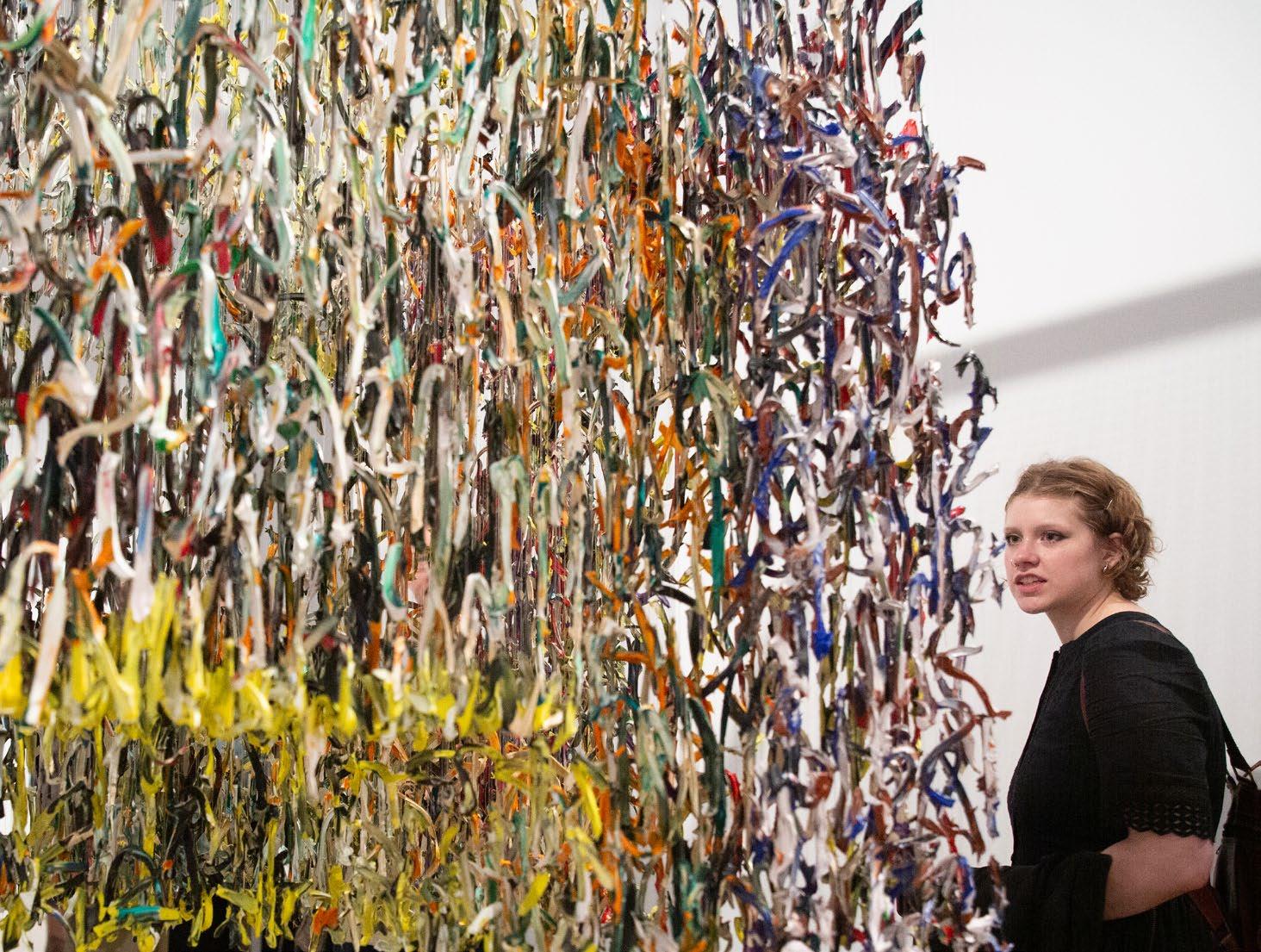
ition four years in the making had its U of M opening at the School of Art Gallery last week, where it summoned 100 years of ghost photography through a blend of contemporary art and historical photographs.
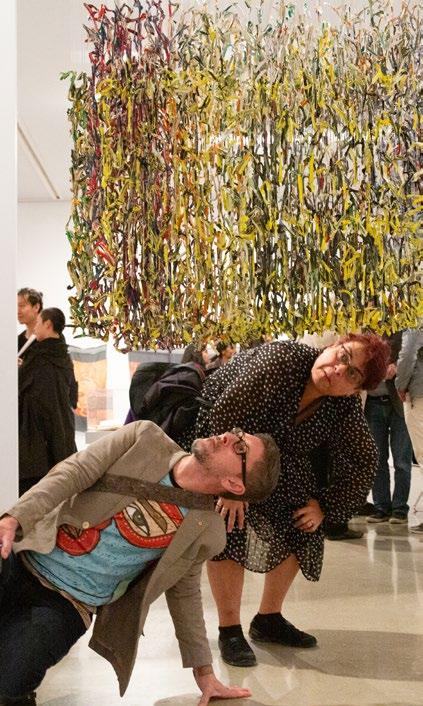


The Undead Archive: 100 Years of Photographing Ghosts is open at the School of Art Gallery, the UM Archives and at the University of Winnipeg in Gallery 1C03.
The exhibit is based on archival ghost photographs taken by Winnipeg physician Thomas Glendenning Hamilton and nurse Lillian Hamilton in the 1920s and ’30s.
The couple were inspired by Sir Arthur Conan Doyle’s lecture titled “Proofs of Immortality,” which he gave in Winnipeg about 100 years ago. The Undead Archive honours the work of its predecessors by recreating and re-establishing the artistry of psychical sci-
ence.
Serena Keshavjee, professor of art and architectural history at the University of Winnipeg and curator of The Undead Archive, said the artists involved in the exhibit were essentially creating in response to the photographs.
tions and spiritualist phenomena” through photography for 20 years.
When asked if she had any favourite pieces, Keshavjee said it’s impossible to choose.
“With archives, you get to see these forgotten, suppressed or lost histories”
— Serena Keshavjee, Curator of The Undead Archive: 100 Years of Photographing Ghosts
There are 25 artists featured in the exhibit, including Estelle Chaigne from France. Chaigne reimagined some of the archival images in reference to an automatic writing phenomenon of the 19th century, which held that spirits were able to communicate through individuals in hypnotic states, and they would write out what they were hearing. Also on display is work by American artist Shannon Taggart, who Keshavjee said has documented “ectoplasmic excre-
“I love each and every one of them,” she said. “They were all very, very carefully picked.”
While the original archival photos serve as the basis for the exhibit’s new creations, Keshavjee noted that they are more than just inspiration for other work.
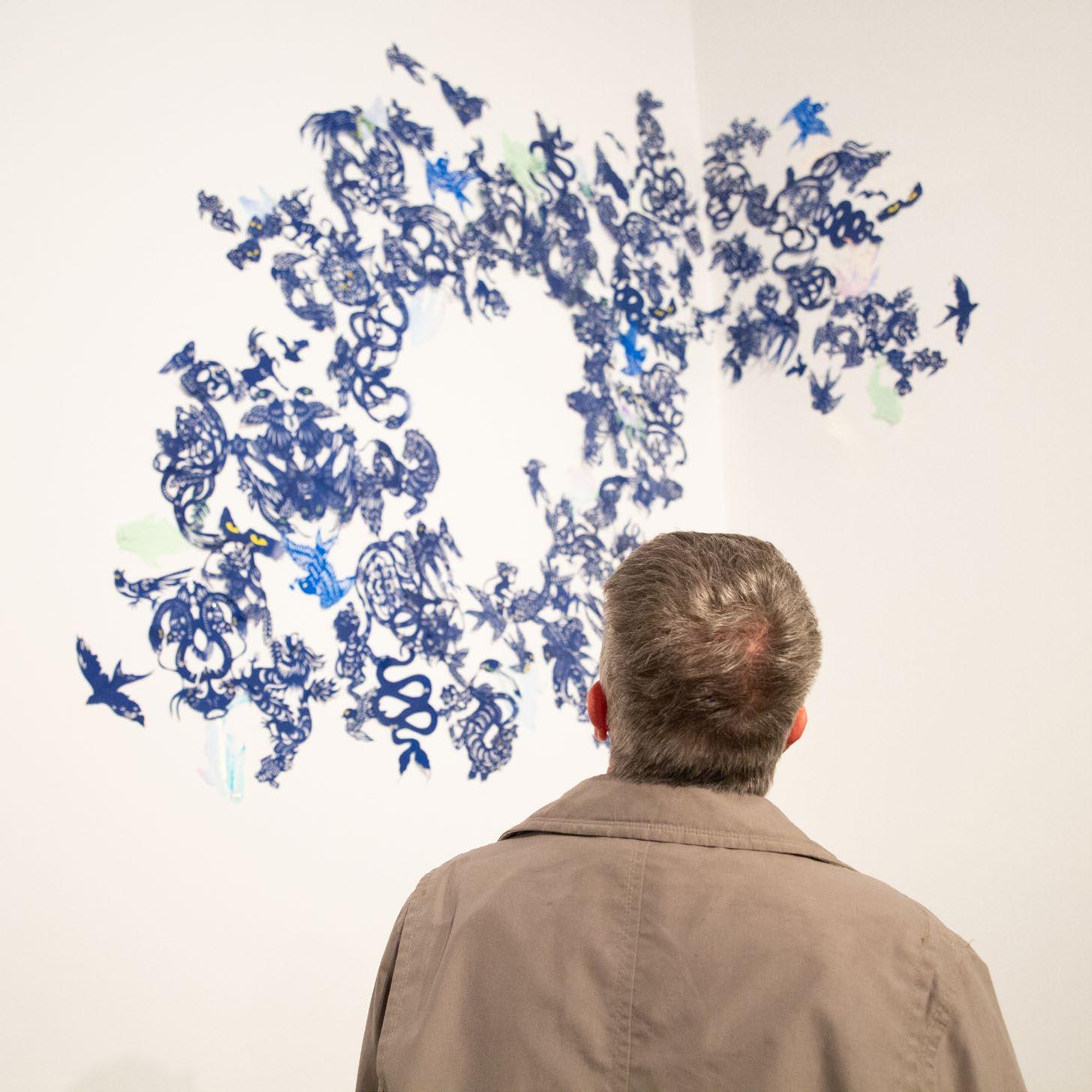
“I do find them artistic in themselves,” she said. “I find them very sophisticated technologically and aesthetically really appealing, and clearly I’m not the only one.”
However, the significance of the photographs goes beyond the artistic. The photos make up “one of the most important psychical science archives in the world,” Keshavjee said, adding that the people who took them “understood them as scientific documents.”
For Keshavjee, the images are one example of why historical archives are important.
“With archives, you get to see these forgotten, suppressed or lost histories,” Keshavjee said.
“To me it was really important to showcase this rich archive that we have here down the road, and then also to show how archives first of all introduce or reveal these forgotten histories, but [also] how they can continue to be important in pop culture.”
Programming related to the exhibition will be taking place until November, and Keshavjee’s book, The Art of Ectoplasm: Encounters with Winnipeg’s Ghost Photographs, launches Nov. 1 at the Grant Park McNally Robinson location.
The Undead Archive: 100 Years of Photographing Ghosts will be featured in Gallery 1C03 at the U of W and in the School of Art Gallery at the U of M until Nov. 10. UM Archives & Special Collections will feature the exhibit in room 330 of Elizabeth Dafoe Library until April 21, 2024. All venues are free to attend.
— with files from Gillian Brown
arts@themanitoban.com
15 arts@themanitoban.com September 27, 2023 Arts & Culture
photos / ebunoluwa Akinbo / staff
Twilight is camp and I was wrong to be a hater
A review of Astral Projection’s screening of Twilight
Jacob Davis, staff
Unlike most 13-yearolds of my generation, I did not have a strange parasocial connection and love for Twilight (2008).
My vampiric interests were solely based on Interview with the Vampire: The Vampire Chronicles (1994) and Queen of the Damned (2002), adaptations of Anne Rice novels. It was because of this particular preference for non-sparkling vampires that I felt superior to others my age for what was, to my 13-year-old mind, my completely unique and intellectual taste.
At the time, I refused to engage in the Twilight craze that was consuming my school. After all, the film was undoubtedly bad, and I assumed I wasn’t missing out on anything. Boy, was I wrong.
Fast forward to over a decade later, when during the first mandated lockdown of the COVID-19 pandemic, I impulsively decided to watch the film for the first time.
Let me tell you, I was furious nobody told me the movie was so unbelievably camp.
The extremely exaggerated acting, the late 2000s soundtrack — in my opinion the highlight of the film — and Bella Swan’s occasional strange fashion choices indicative of the stylistic aesthetics of the time help create this hilariously “so bad it’s good” atmosphere.
Having missed out at the time of the film’s release, I
immediately bought a ticket when the Dave Barber Cinematheque announced it would screen Twilight as a part of its Astral Projection series.

The monthly screening series, curated by Cinematheque box office manager Nic Kaneski, features films with directors who have astrology signs corresponding to the current zodiac season.
Arriving at the theatre a few minutes before the screening to get my seat and meet up with some friends, I was surprised to see a handful of others with the same idea. Excitement was definitely in the air as fellow Twilight attendees chatted in the Cinematheque lobby.
Once attendees found their seats, Kaneski took to the stage to welcome and introduce us to the screening.
“I think that the first movie really stands out from all the other ones in a lot of ways,” Kaneski said, adding that as a Libra, director Catherine Hardwicke’s “respect for the romance and the seriousness” of the material is reflected in the film. Hardwicke had worked on the film Thirteen (2003) prior to Twilight, and Kaneski said her “curiosity and respect for the subject matter of teenage girls” and her audience “shined through.”
Moved by such a meaningful analysis, I settled in and the film began. However, nothing could prepare me for the next two hours.
Almost immediately after the film’s first line— which sees Bella launch into a brief existential monologue on death — the audience began to holler, and the screening quickly became infused with audience participation.
People laughed at the outrageous second-hand embarrassment from some scenes and cheered when their favourite characters walked into a room for the first time. My friend even started a Rocky Horror Picture Show-like participation activity where people would dramatically say the silliest lines out loud together.
The audience was never completely quiet. Occasionally, things would drop down to a whisper, but before long a memorable scene would cause excited uproar once again.
The best part of it all was that, despite being a new fan of the film myself, I felt completely at home at the event. Twilight was such a cultural phenomenon that, even though I did not see it at release, I already knew some of the jokes that surrounded the film. Still, it felt good to be in on them in a genuine manner here.
Seeing Twilight on the big screen was a completely different experience from seeing it on my laptop during the lockdowns. I picked up on things I had not noticed before, such as Bella’s blue eyeshadow or the terrible wigs worn by almost every actor.

It was like truly seeing Twilight for the first time, in all its cringe and beautiful glory.
The audience met the film’s ending with cheers and applause, and I left the Cinematheque feeling like I had healed my inner child, who hadn’t had the chance to be an obsessive Twilight kid.
This film was a perfect choice for the Libra season of Astral Projection. It was one of the most fun screenings I have been to in a while.
The next Astral Projection screening is for Scorpio season, where the Cinematheque will be showing May (2002), a horror film about a
young woman whose desire for human connection turns twisted and deadly. Although it’s no Twilight, as a new fan of Astral Projection and a Scorpio myself, I will definitely be returning to the cinema to see it.
The Dave Barber Cinematheque will be screening May on Oct. 25 at 7 p.m. More details can be found on the Cinematheque’s website.
arts@themanitoban.com

16 arts@themanitoban.com Vol. 110, No. 07 Arts & Culture
photos
/ Jacob Davis / staff
Swimming programs for all levels return in October
Masters Swim Club offered for experienced swimmers as campus pool reopens
Anne
Grace
paizen, staff
With the reopening of the Fort Garry campus’ Joyce Fromson Pool Oct.
1 comes swimming programs offered to students of all skill levels — whether just learning to swim or for the more advanced swimmer.
While introductory and intermediate swimming lessons are offered in the fall and winter semesters for students who are either learning how to swim, or who would like to improve their swimming, there are also two other programs geared toward advanced swimmers.
Junior Bisons swimming coach and Bisons swim team assistant coach Dillon Perron — a former decorated Bisons swimmer, who set a provincial record in men’s 100metre breaststroke in 2014 — is enthusiastic about the “ever expanding” swimming programs offered on campus.
Perron said when he started swimming at the University of Manitoba, “swimming on campus was essentially just university athletes,” before the university started expanding its programming to swimming lessons.
“In the last two years or so, [the U of M has] also brought in a third avenue of swimmers, and that is what we call ‘masters’ athletes,” Perron explained, adding that these athletes are “generally adults who are looking for fitness or some competitive swimming.”
There are two Masters Swim Club programs. The first, the Bison Masters Triathlon Swim Club, is offered Tuesday and Thursday mornings from 6 to 7:30 a.m., while the second, the Mid-Can Bison Masters Swim Club, is offered Sunday mornings from 8 to 9:30 a.m. and Tuesday and Thursday evenings from 8 to 9:30 p.m.
“The morning program is
more directed towards people who want to participate in triathlons,” Perron said. “Or, maybe they don’t even want to do triathlons but they like training for triathlons.”
“And then we have an evening program on Tuesdays and Thursdays, that’s more [of] a conventional swimming program where you’re going to cover all four strokes — breaststroke, backstroke, butterfly and freestyle — and the technical development of those as well as the fitness component.”
Perron emphasized that the programs are for “anybody over the age of 18 who’s interested in either just staying fit [and] being in the water, or potentially there’s somebody who wants to do some competing in the summer.”
The first sessions of both Masters Swim Club programs are set for Oct. 3 once the Joyce Fromson Pool reopens on Oct. 1, and all sign-ups to swim programming on campus can be conveniently found online on the Sport and Rec facilities website.
For students hesitant to sign up or who are worried about time commitment, Perron emphasized the flexibility of the program.
“If they’re going to do the triathlon program, they can either come just Tuesday or just Thursday or both Tuesday and Thursday,” Perron said.
“And if they’re going to do the other program [...] same deal, they can come one time a week, two times a week or three times a week.”
While swimming programs on campus are not covered by the Sport and Rec fee, the prices for the programs that run the duration of the desired semester are manageable for those interested.
The Bison Masters Triathlon Swim Club program starts
at $267.15 and the Mid-Can Bison Masters Swim Club program starts at $340.55.
Perron also stressed that the Masters Swim Club programs are not for beginners.
“It’s not a learn to swim [program],” Perron explained. “You have to have some fundamentals.”
For students learning to swim, an Adult Introduction to Swimming course is offered for $147. Students who are intermediate swimmers can sign up for the Adult Intermediate Swimming Lessons, which are offered for the same price.

While there are private and semi-private swimming lessons students can sign up for as well, they are more expensive at $389.00.
Perron also noted that students who are experienced swimmers should not be reluctant to sign up for the Masters Swim Club programs if they are worried about a ser-
ious training environment.
“It’s a low-pressure environment to have fun and get fit and challenge yourself,” Perron said. “There’s no expectations for, ‘you have to be this fast,’ or anything like that.”
“There’s quite a spectrum in both programs,” he said. Perron added that swimmers of different speeds swim in different lanes, “so generally you’re not going and being overwhelmed and getting run over.”
Perron said the program coaches understand that students have school and work, so students arriving a few minutes late or having to leave early is completely fine.
He added that these programs offer a drop-in session that students can attend for free, so there’s no pressure on students who do not end up liking the program.
said fellow former national swimmer Taylor Hardman will be teaching the Mid-Can Bison Masters Swim Club.
“You can almost think of it as a fitness class, like a Zumba thing,” Perron said.
“It’s a structured environment for people who like to be in the water, but who are, really, kind of at a loss for what to do in the water.”
For any questions about the Masters Swim Club, students can email Perron at dillon.perron@umanitoba. ca, and students can register for swimming lessons at sportsandrec.umanitoba.ca.
Perron himself will be teaching the Bison Masters Triathlon Swim Club, and he sports@themanitoban.com

17 sports@themanitoban.com September 27, 2023 Sports
photo / e bunoluwa Akinbo / staff

Hockey season preview
Bisons to watch for in the 2023-24 season
Grace Anne paizen, staff
T he Bisons women’s and men’s 2023-24 hockey seasons begin this week with both teams playing a back-toback series against the University of Saskatchewan Huskies. The women start their season on the road in Saskatoon, playing Friday and Saturday night, while the men will play at home Thursday night before hosting a matinee game on Friday in Wayne Fleming Arena, located on Fort Garry Campus in the Max Bell Centre.
With the opening games set, here are some storylines to follow over the hockey season.
Women’s team
Helmed once again by veteran head coach Jon Rempel, the Bisons women’s team will be looking to improve last year’s record. Having gone 12-16, the herd just missed the CanWest playoffs.
The Bisons went into the final series against the University of Alberta Pandas with their season on the line, needing to win their final two games to secure the last playoff spot in the CanWest standings. However, the Bisons’ 4-1 loss in the first game of the series ultimately eliminated them from playoff contention.
Finishing the season so close to the playoffs is definite motivation for returning players.
Returning goaltender, and a 2021 and 2022 Bison female Athlete of the Week, Kimberley Davidson enters the season with a praiseworthy record. Last season, Davidson recorded an incredible .897 save percentage and 2.65 goals against average, making 200 saves in net.
Other players to watch for on the team are returning forwards Kate Gregoire and Ashley Keller.
Gregoire, who played for the golf team during the 201920 season and was named to the 2019-20 hockey CanWest All-Rookie Team, led the Bisons last season in overall points and goals. The forward recorded 10 goals and eight

assists in the 2022-23 season.
Fellow forward Keller, who was named a Bison female Athlete of the Week, CanWest female Hockey Player of the Week and CanWest Women’s Hockey All-star in the 2021-22 season, recorded a team-leading nine assists and was second overall on the team for points with 13 last season.
Men’s team
The main storyline for the men’s hockey team is centred on its new head coach, Gordon Burnett, who boasts a wealth of experience coaching in the minor leagues. Burnett has big shoes to fill as he replaces long-time men’s team head coach Mike Sirant, who had coached the team since the 1993-94 season and
is the winningest head coach in men’s hockey program history.
However, last season the men’s team also failed to make the playoffs. Having gone 8-20, the herd was relying on help from the out-of-town scoreboard, and needed to defeat the University of Alberta Golden Bears during its final series of the 2022-23 season. Unfortunately, the Bisons lost both games and were eliminated from post-season contention.

Players to watch for on the men’s team this season are returning forward Hayden Ostir, returning defencemen Chase Hartje and returning goaltender Ross Hawryluk.
goals in his last three games. Ostir also tied for second overall in points and goals last season, with 19 points and 10 goals.
Impressively, teammate and one of last October’s male Athletes of the Week Hartje tied Ostir for second overall points, with the defencemen also recording 19 points last season.
Finally, goaltender Hawryluk recorded an impressive .894 save percentage last season, making 505 saves with a 4.18 goals against average.
Ostir was named a Bison male Athlete of the Week this February, having scored six sports@themanitoban.com

19 sports@themanitoban.com September 27, 2023 Sports
photos
/ m atthew
m erkel / volunteer staff
Bison briefs
Grace Anne paizen, staff
Bisons cross-country
The Bisons cross-country team competed at the Roy Griak Invitational hosted by the University of Minnesota on Friday.
Angela Kroeker started where she left off in the previous cross-country season, posting the best Bisons time of 23:34.3 in the women’s 6K race. Rookie Lena Klassen finished close behind with an impressive time of 23:41.2.
Aspen Shier and Emily Watson posted times under 28 minutes, and Lily Francis, Caitlyn Patson and veteran Shayna Giesbrecht all posted times under 29 minutes.
On the men’s side of the cross-country team, veteran Calvin Reimer held the fastest time in the men’s 8K for the Bisons, posting 27:40.1, while Justin Kroeker finished just six seconds behind him.
Rookie Carson Kroeker posted the third fastest Bisons
time on the men’s side with 28:36.3, while Wylie Garchinski and veteran Alexander Brandt-Granding posted times under 30 minutes, and Jonah Leppelmann and Gavin Maxwell posted times under 31 minutes.
The cross-country team will be on the road again on Saturday as the University of Saskatchewan Huskies host the Dakota Classic.
Bisons football
The Bisons football team earned its first win of the season at home in historic fashion.

Bison kicker Maya Turner not only made U Sports history as the first woman to dress for a regular season game, but also became the first woman to make points in a regular season U Sports game, putting 9 of the herd’s 27 points on the board, including a game-winning 21-yard field goal in second overtime.
The afternoon game also saw the return of quarterback Jackson Tachinski from injury, who threw for 323 yards and had two rushing touchdowns.
The herd looked well matched against the University of Regina Rams, as the first points of the game came late in the first quarter when Bisons kicker Vinny De Rosa conceded a safety after the herd started deep from the three-yard line.
It was in the beginning of the second quarter that the magic began to happen for the Manitoban squad. Marching deep downfield, Turner put the Bisons’ first points on the board with a serendipitous 21-yard field goal, making U Sports history.
With the Rams taking a 9-3 lead into halftime, the herd came out big in the third quarter to tie with a touchdown from receiver De Shawn Le Jour. Turner would put her fourth point on the board with
the 1-point conversion.
The Rams and Bisons would exchange four touchdowns before Regina pulled off the two-point conversion, forcing overtime.
After the first overtime came to an end without any points, the Bisons would start the second mini-game, where Turner would put up Manitoba by three. With a huge stop by the defence in the Rams possession, the Bisons would go on to win their first game of the season 27-24.
The herd’s defence had a tremendous game, forcing three two-and-outs, a turnover on downs and six breakups. Defensive linemen Cole Barron and Tristan Francis and defensive back Stephen Adamopoulos all recorded a sack. Adamopoulos would also record the lone interception of the day, and defensive tackle Collin Kornelson would record the lone forced fumble.
The Bisons will host the University of Calgary Dinos in another matinee game on Sunday at IG Field.
Bisons women’s soccer
It was a tough road trip for the Bisons women’s soccer team this past weekend. Travelling to the West Coast, the herd made its first stop in Victoria, B.C. to take on the University of Victoria Vikes at Centennial Stadium on Friday night.
fantastic, stopping nine of the 11 shots on net.
The scary part of the game came in the 57th minute, when Bisons defender Ava Memka went down after defending a scramble at the herd’s net. She needed assistance off the field and did not play during Sunday’s game.
On Sunday, the Bisons were hosted by the Mount Royal University Cougars in Calgary. The herd had a strong start, pressuring the Cougars straight out of the gate and opening the scoring in the 24th minute with a beautiful header from rookie midfielder Taryn Cabak off a corner from fellow midfielder and captain Jessica Tsai.
Taking the 1-0 lead into halftime, the herd held off Mount Royal until late in the game when the Cougars would receive three penalty kicks in the last 18 minutes. All three kicks would make their way past Bagi to put the Cougars up 3-1 and ultimately win them the match.
However, the silver lining in the second loss of the weekend was Bagi making program history yet again. With her six stops against the Cougars, Bagi is now second all-time in the Bisons program record books for most saves, surpassing former Bison goaltender Chloe Werle’s record.
This next weekend marks the herd’s bye week before starting the final leg of the season at home with the Duckworth Challenge Oct. 7.
The Bisons were outshot, only recording two shots on goal, courtesy of midfielders Chloe Morin and rookie Lulu Bordeaux. Again, veteran goalkeeper Karina Bagi was sports@themanitoban.com
Sports teams’ schedules
20 sports@themanitoban.com Vol. 110, No. 07 Sports
U of M Bisons — Women’s Hockey Bisons @ Saskatchewan Huskies Sept. 29 — 8 p.m. Bisons @ Saskatchewan Huskies Sept. 30 — 6 p.m. U of M Bisons — Women’s Soccer Bisons @ Victoria Vikes Sept. 22 — Final: 0 – 2 Bisons @ Mount Royal Cougars Sept. 24 — Final: 1 – 3 Winnipeg Wesmen @ Bisons Oct. 7 — 12 p.m. Bisons @ Winnipeg Wesmen Oct. 8 — 3 p.m. U of M Bisons — Men’s Hockey Saskatchewan Huskies @ Bisons Sept. 28 — 7 p.m. Saskatchewan Huskies @ Bisons Sept. 29 — 2:30 p.m. U of M Bisons — Cross Country Dakota Classic Sept. 30 U of M Bisons — Football Regina Rams @ Bisons Sept. 23 — Final: 24 – 27 Calgary Dinos @ Bisons Oct. 1 — 2 p.m. U of M Bisons — Golf Canada West Championships Oct. 2–3 Valour FC Vancouver FC @ Valour Sept. 20 — Final: 1 – 0 Valour @ Atlético Ottawa Sept. 24 — Final: 1 – 0 Valour @ Cavalry FC Sept. 29 — 8 p.m. Winnipeg Blue Bombers Toronto Argonauts @ Bombers Sept. 29 — 7 p.m. Bombers @ B.C. Lions Oct. 6 — 9 p.m. *All times CDT photo / m atthew m erkel / volunteer staff










 Sarah Cohen, staff
Sarah Cohen, staff




















































